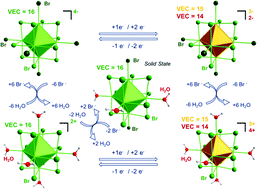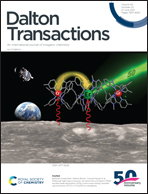Revisiting properties of edge-bridged bromide tantalum clusters in the solid-state, in solution and vice versa: an intertwined experimental and modelling approach†
Abstract
Edge-bridged halide tantalum clusters based on the {Ta6Br12}4+ core have been the topic of many physicostructural investigations both in solution and in the solid-state. Despite a large number of studies, the fundamental correlations between compositions, local symmetry, electronic structures of [{Ta6Bri12}La6]m+/n− cluster units (L = Br or H2O, in solution and in the solid-state), redox states, and vibrational and absorption properties are still not well established. Using K4[{Ta6Bri12}Bra6] as a starting precursor (i: inner and a: apical), we have investigated the behavior of the [{Ta6Bri12}Bra6]4− cluster unit in terms of oxidation properties and chemical modifications both in solution (water and organic solvent) and after recrystallization. A wide range of experimental techniques in combination with quantum chemical simulations afford new data that allow the puzzling behavior of the cluster units in response to changes in their environment to be revealed. Apical ligands undergo changes like modifications of interatomic distances to complete substitutions in solution that modify noticeably the cluster physical properties. Changes in the oxidation state of the cluster units also occur, which modify significantly their physical properties, including optical properties, which can thus be used as fingerprints. A subtle balance exists between the number of substituted apical ligands and the cluster oxidation state. This study provides new information about the exact nature of the species formed during the transition from the solid-state to solutions and vice versa. This shows new perspectives on optimization protocols for the design of Ta6 cluster-based materials.



 Please wait while we load your content...
Please wait while we load your content...